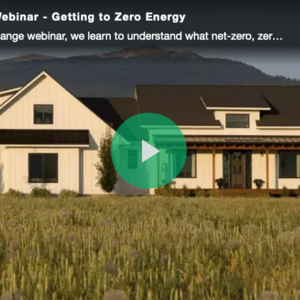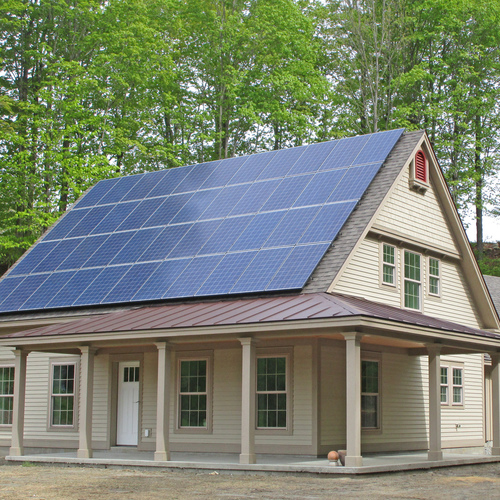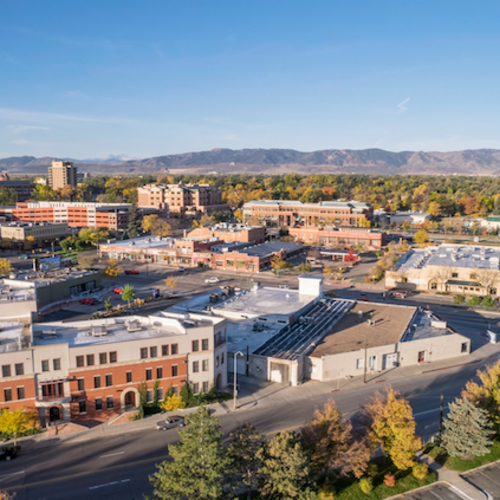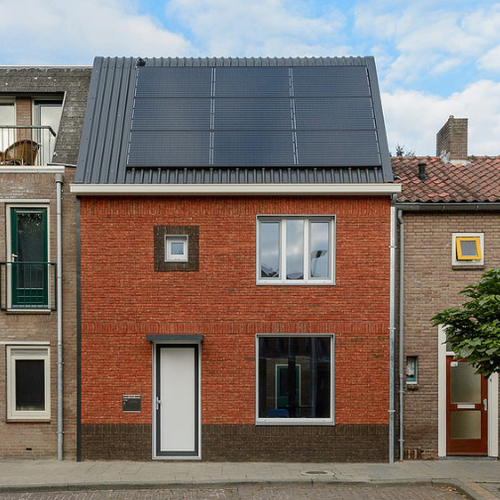Image Credit: Byggmeister
Image Credit: Byggmeister The owners are highly motivated, but the house was “a tired and worn century-old colonial.” After a major overhaul, the house should be capable of net-zero energy performance.
A few months ago we completed a deep energy retrofit of a house that we hope will be net-zero energy — in other words, that we hope will produce as much energy as it consumes on an annual basis. If we succeed, this will be our first net-zero project.
There are two key strategies for designing a net-zero-ready home: you minimize the amount of energy the house needs to operate; and you maximize the amount of energy that the house can produce onsite, usually with a photovoltaic system (PV). In short, you create an energy budget that balances consumption with production.
Implementing these strategies on a new home is relatively straightforward. In fact, leaders in the high-performance building industry have been building net zero ready homes for years now, and some are even doing so at market rate. (To learn more about one Massachusetts company, Transformations Inc., that is building market-rate and affordable net zero energy homes, click here.)
Weekly Newsletter
Get building science and energy efficiency advice, plus special offers, in your inbox.
Existing houses are a bigger challenge
The same can’t be said for existing homes. On the contrary, retrofitting a home to operate on a net-zero basis is a pretty audacious undertaking. Most of the homes we work on push back hard against such ambition. There are several obstacles, including our relatively harsh climate; the older, architecturally complex character of our housing stock; the frequency with which homes have been renovated without attention to efficiency; and the prevalence of smaller lots, particularly in urban settings.
But with this project we had two things going for us: a relatively accommodating building, and highly motivated homeowners (not to mention our top-notch planning team, led by David Foley of Holland and Foley Architecture).
The home’s relatively simple form made it possible for us to superinsulate the building shell and drastically cut air leakage. This drove the heat loss down low enough that we were able to significantly downsize the mechanical system, replacing the existing gas boiler with three minisplit heat pumps for both heating and cooling. (Heat-recovery ventilation ensures a steady supply of fresh air.)
Equally important is the home’s unshaded south-facing roof, which supports an 11.7-kW PV system projected to produce 15,000 kWh per year, or 120% of what the house is modeled to consume. (For context: according to the Energy Information Administration, the average Massachusetts household consumes roughly 32,000 kWh annually, or two and a half times as much as this house).
It’s up to the homeowners to make it work
Now it’s up to the highly motivated homeowners to actually make it to net zero — i.e., to live within their energy budget. We are currently in the process of gathering monthly usage and production data to determine how close we get to this goal. We are also monitoring at a more finely grained level, increasing the likelihood that we will be able to get there.
With the help of the SiteSage eMonitor system, we are collecting circuit-by-circuit usage data. Monitoring this closely has several purposes, not least of which is it tells us whether equipment is working properly. When a usage pattern looks atypical, we can sometimes use the eMonitor to help us troubleshoot in real-time.
We can also use circuit-by-circuit monitoring to help the homeowners develop net zero “habits” — to give them the feedback they need to live within their energy budget. We can let them know when they’re at risk of exceeding their budget and overdrawing their “energy account.”
While in many respects living in a net-zero energy home is easier than living in a standard home (for one thing, a well-designed net-zero energy home is far more comfortable from a thermal standpoint), net-zero living does take some adjustment. Much of the conventional wisdom about operations and maintenance, particularly in regards to mechanical equipment, doesn’t translate well to low energy homes.
For example, minisplit heat pumps operate most efficiently when they are maintained at a fairly constant temperature. The eMonitor data can help us identify whether the homeowners are laying down a net-zero habit of “setting and forgetting” their minisplits, or are falling back into a habit of using setbacks.
It remains to be seen whether we will achieve our goal of net zero energy. If we do, there’s no question that thoughtful operations on the part of the homeowners, supported by monitoring on our part, will have played a key role in getting us there — at least as key as lucking into such an accommodating house in the first place.
Paul Eldrenkamp is the owner of Byggmeister, a design/build firm based in Newton, Mass. Rachel White is the company’s performance manager. This blog, the third in a series of posts about the project, originally was published at the Byggmeister website. The first and second posts are Preparing a Historic Home for the Next 100 Years, and Planning for Net Zero Energy.
















14 Comments
Forcing people to stay in the
Forcing people to stay in the energy budget may work for motivated retrofitters and eco minded consumers but not for the average person. Notice the resistance to even modest regulation, building codes and safe to drink water are an affront to free speech by many voters (until they suffer personally, then they blame the government).
So if its designed to be net zero and people go over it you can simply charge them extra, "free energy" is xkW, going over is the retail rate which is likely to rise in the future anyways. High gas prices caused a lot of grumbling but did reduce consumption.
32,000 kWh Annually? Not so fast!
Stating that the average Mass. home uses 32,000 kWh annually strikes me as a disingenuous use of the statistic that the average Mass home used about 110 million Btu during 2009 per the linked EIA report
Converting the 110 million Btu to equivalent electricity is invalid considering that the vast majority of Massachusetts homes use a fossil fuel for heat and that fuel burn constitutes a substantial, in many cases majority of the homes total energy usage.
Response to Curt Kinder
Curt,
As far as I can tell, the house discussed in this blog is an all-electric house. The authors wrote, "we were able to significantly downsize the mechanical system, replacing the existing gas boiler with three minisplit heat pumps for both heating and cooling."
This house apparently has an energy budget of 12,500 to 15,000 kWh per year. Since this energy budget covers everything -- appliances, lighting, plug loads, space heating, and domestic hot water -- it is entirely appropriate to compare that budget with the average energy use of a Massachusetts house (including the space heating fuel).
the house is all-electric
Yes, the house described is all-electric.
This piece is a a few months out of date: We now know that the first year the house was net energy positive by about 8000 kWh. So this year the homeowner is kicking back a bit and inviting the neighbors to run extension cords from their built-in wine cellars to his exterior receptacles.
kWh vs Therms
Since so much of the perceived value in going Net Zero is the economics, I think it's important to not mix the metrics. Per the linked EIA infographic on MA total energy use is 1,100 Therms or 32,000 kWh. when we convert to dollars we get 32,000 kWH = $5,241.60 annual cost at 0.1638 kW but if we use 1,100 Therms (110MBTU) = $1,408 annual cost at $1.28 Th. Definitely skews our ROI. The average home in Mass. pays $2500/ year or $208.33 month for all residential energy.
If the house could be ZNE retrofitted for $50,000 a 20 year loan at 4.5% would have $316.32 monthly payments (assuming no maintenance or replacements).
not the economics
Tommy,
If there's perceived value in the economics of a net zero retrofit, it's mostly among people who have not actually done one. Not to say there aren't other reasons for undertaking such a project.
Response to Tommy Young
Tommy,
Considering the 30% federal tax credit and the SRECs available in Massachusetts, the big returns come from the rooftop PV, which is a high-yield investment that no one should ignore.
The investments in insulation upgrades, air sealing, and efficiency improvements? Those are not as good an investment -- by a long shot.
Totally agree - not the economics
very true, Paul. I do things all the time and chalk them up to "supporting our local economy" ; head to the local microbrewery, have the dealer change my oil etc... I do believe there are many reasons to chase ZNE and I admire those that do.
I am out here in CA where we're being mandated to chase after it - supposedly all new res construction must be ZNE in 779 business days and every now and then an official will float the idea of mandatory ZNE retrofits for existing. The average utility bill total in CA is $140- if we get a 50% reduction in usage what can a homeowner finance for $70/month?
DER and Net-Zero
I know we've all discussed this before, but I'll add my 2 cents. Building an energy efficient home from scratch (so to speak) is certainly an easier operation than retrofitting. However it should be noted that a gut and retrofit should not be confused with a DER. If you are doing a DER exclusively because you want to do a DER, there is no way it can pay for itself. If, on the other hand, you are renovating an old house (like we are doing to a 1901 Victorian), and updating the plumbing, knob and tube wiring, 1950s fire damage and so on, then the added expense of making the house super efficient is really quite negligible. The added expense of better windows and doors, extra insulation, and so on is really less than $10,000. The vast expense is all the stuff that would go into a new house, independently of efficiency upgrades. In an area that typically builds new (code-standard) homes, for around $225/ft2, we are renovating a classic brick building (with new everything, except the shell) for less than $100/ft2, so in the end, cheaper than a new build but with all the efficiency upgrades. And we haven't added the PV panels yet!
Response to Martin
"Curt,
As far as I can tell, the house discussed in this blog is an all-electric house. The authors wrote, "we were able to significantly downsize the mechanical system, replacing the existing gas boiler with three minisplit heat pumps for both heating and cooling."
This house apparently has an energy budget of 12,500 to 15,000 kWh per year. Since this energy budget covers everything -- appliances, lighting, plug loads, space heating, and domestic hot water -- it is entirely appropriate to compare that budget with the average energy use of a Massachusetts house (including the space heating fuel)."
I never doubted that the subject home is all-electric, and I agree that it is both valid and useful to compare its energy consumption to that of other Massachusetts homes.
I stand by my objection to the statement that the average Massachusetts household consumes 32,000 kWh annually. That simply isn't true.
The EIA report from 2009 indicates that the average Mass home used 110 million Btu. That converts to roughly 32,000 kWh, but using that conversion as the basis for the statement that Massachusetts homes / households consume an average of 32,000 kWh would require that:
1) The average Mass. home be all-electric
2) That said all-electric homes derive all their heat from electric resistance
Both of the above are patently false - the vast majority of Mass homes burn fossil or wood fuel for heat. While some of the few that are all-electric might rely solely on resistance heat, the cost to operate same would be crippling. Modern all-electric Mass homes would have to employ heat pump(s) for heating at a COP of somewhere between 2 and 4 in order not to bankrupt their owners during winter...and that's the thrust of this and several other threads advocating use of minisplit heat pumps in northern climate zones.
Perhaps I'm wrong and there is data supporting the assertion that 32,000 kWh annually passes through the average Mass home's utility electricity meter, but I very very much doubt it.
Response to Curt Kinder
Curt,
You are evidently under the misapprehension that kWh is a unit that only applies to electricity. It's not. We can measure energy in kWh or BTU; it's easy to convert between these two units, and either unit can be used for either electrical energy or thermal energy.
Similarly, we can measure power in kW or BTU/h; either unit can be used for electrical power or thermal power.
To take just one example: In the U.S., we measure the power of a boiler in BTU/h, but in the U.K., they usually measure the power of a boiler in kW. When a British plumber talks about a 30-kW boiler, that doesn't mean it's an electric boiler. It's usually a gas boiler. (For example, here is a link to a British web page which discusses the size of gas boilers in kW.)
If these concepts are new to you, you should play around with these conversion factors:
1 watt = 3.4129 Btu/h
1 Btu/h = 0.2931 watts
1 kW = 3,412.9 Btu/h
1 kWh = 3,412.9 Btu
So the statement that the average Massachusetts family uses 32,000 kWh of energy per year doesn't mean that all of the energy use is electrical energy. Some is electrical energy, and some is thermal energy. To add it all up, though, we need to use consistent units. If you prefer to use BTU instead of kWh, it's just as accurate to say that the average Massachusetts family uses 109,212,800 BTU per year -- some in the form of thermal energy, and some in the form of electrical energy.
The house that Paul Eldrenkamp and Rachel White discuss in this article uses significantly less energy than the average Massachusetts house, as the authors accurately report.
Response to Martin
Martin,
I'm under no such misapprehension, and I certainly had no need of a lesson in power unit conversion factors. I made the conversion from MMBtu to kWh in the post immediately above yours.. I hope your goal in posting those figures was to inform others rather than insult me.
I stand by the assertion that the average reader here will interpret quantities given in kWh as electricity and while saying that Mass homes use 32,000 kWh annually may technically accurate it stands a fair chance of conveying wildly false information.
I get that other countries use different units (It is ironic that we use the Brit unit of heat output while they use kW).
Unless and until we in the US start buying and selling natural gas, propane, diesel fuel and heating oil by the kWh, stating energy consumption of those fuels in kWh misinforms.
Anyone for gas pumps calibrated in kWH? gasoline sold at 6 cents per kWh works out to a bit over $2 per gallon.
By your reasoning I could accurately state that my 22 MPG car uses 1.60 kWh / mile. Or the reciprocal of that - 0.624 miles per kWh...accurate but useless at actually communicating useful information.
Response to Curt Kinder
Curt,
I certainly didn't intend to insult you. I evidently misunderstood your comment. I apologize for my misunderstanding.
That said, it is very common to convert energy units from BTU to kWh, and back again, when calculating the total annual energy use for a house. We do it all the time here at GBA, and so does the Energy Information Administration. It's common to calculate the total energy use of a house -- a way of including electrical usage as well as domestic hot water and space heating -- and unless you convert all forms of energy into a common unit (either kWh or BTU), there's no way to calculate such a total.
If you prefer BTU to kWH, the conversion is simple (as you clearly know). So call it 109,212,800 BTU per year if you prefer. It amounts to the same thing.
As I'm sure you also know, there are two ways to report the annual energy use of a home: as site energy or source energy. The totals discussed in this article are site energy totals.
Units of energy
Martin,
Thank you - I understand the usefulness of a single figure to convey and compare a home's annual energy use. I find it difficult to divorce energy units from sources - If Btus are in hand, something was burned to obtain them; any mention of Watts / kWH has to involve (in my mind, anyway) an electric utility meter.
Site vs source energy is a whole different kettle of fish highly dependent upon the local electric utility's generation mix which in turn varies by time of day and across seasons.
All the "equivalency" calculations out there will be devilish details for decades...two spring to mind:
1) Pure electric cars rated in "Miles Per Gallon Equivalent" - the typical figure is 100+, even though not a drop of gasoline is burned, never mind gallons.
2) LED lamps described in incandescent "Watt-equivalent". 60, 75, and 100 Watt incandescent bulbs are essentially gone from shelves, replaced first by CFLs and then by LEDs...at some point shoppers will have no memory of the older bulbs to which newer are compared. Will consumers eventually learn to substitute lumens for Watts and along the way learn that the figure of merit is Lumens per Watt? Will additional considerations such as color temperature and color rendering index render the whole light bulb issue too complicated for average consumers to understand?
Log in or create an account to post a comment.
Sign up Log in